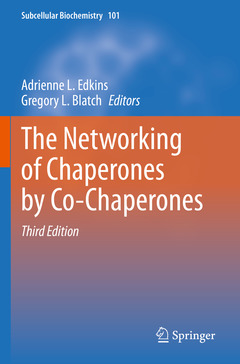The Networking of Chaperones by Co-Chaperones (3rd Ed., 3rd ed. 2023) Subcellular Biochemistry Series, Vol. 101
Coordonnateurs : Edkins Adrienne L., Blatch Gregory L.

Co-chaperones are important mediators of the outcome of chaperone assisted protein homeostasis, which is the dynamic integration of the processes of protein folding, degradation and translocation to ensure that cellular function is finely tuned in space and time.
This third edition of the book The Networking of Chaperones by Co-chaperones describes how the function of the major molecular chaperones is regulated by co-chaperones, a diverse cohort of non-client proteins. Since the second edition was released, not only has knowledge deepened on how co-chaperones act as nodes to network and functionalise chaperones, but an understanding of their broader biological function has started to emerge. The third edition provides new and updated chapters highlighting recent developments and emerging themes on co-chaperones, such as their extracellular functions, their role in human disease and their status as putative drug targets.
The book is a useful resource for both newcomers and established researchers in the field of cell stress and chaperones, as well as those interested in cross-cutting disciplines such as cellular networks and systems biology.
CHAPTERS
1. GrpE, Hsp110/Grp170, HspBP1/Sil1 and BAG domain proteins: Nucleotide exchange factors for Hsp70 molecular chaperones
Andreas Bracher (bracher@biochem.mpg.de) and Jacob Verghese
2. Functions of the Hsp90-Binding FKBP Immunophilins
Nina R. Ortiz, Naihsuan Guy, Yenni A. Garcia, Jeffrey C. Sivils, Mario D. Galigniana, and Marc B. Cox (mbcox@utep.edu)
3. Hsp70/Hsp90 organising protein (Hop): coordinating much more than chaperones
Kelly Schwarz, Swati Baindur-Hudson, Gregory Lloyd Blatch, Adrienne Lesley Edkins (a.edkins@ru.ac.za)
4. Specification of Hsp70 function by Hsp40 Co-Chaperones
Douglas M. Cyr (dmcyr@med.unc.edu) and Carlos H. Ramos (cramos@iqm.unicamp.br)
5. Cdc37 as a Co-chaperone to Hsp90
Thomas L Prince, Benjamin J Lang, Yuka Okusha, Takanori Eguchi, Stuart K. Calderwood (scalderw@bidmc.harvard.edu)
6. p23 and Aha1 – Distinct functions promote client maturation
Maximilian M. Biebl and Johannes Buchner (johannes.buchner@tum.de)
7. Beyond chaperoning: UCS proteins emerge as regulators of myosin-mediated cellular processes
Odutayo O. Odunuga (odunugaoo@sfasu.edu) and Andres F. Oberhauser (afoberha@utmb.edu)
8. Chaperonin - Co-Chaperonin Interactions
Aileen Boshoff (a.boshoff@ru.ac.za)
9. Co-chaperones of the human endoplasmic reticulum: an update
Armin Melnyk, Sven Lang, Mark Sicking, Richard Zimmermann (richard.zimmermann@uks.eu) and Martin Jung
10. J Domain Proteins Orchestrate the Multifunctionality of Hsp70s in Mitochondria: Insights from Mechanistic and Evolutionary Analyses
Jaroslaw Marszalek (jmarszalek@wisc.edu), Elizabeth A. Craig (ecraig@wisc.edu) and Bartlomiej Tomiczek
11. Impact of co-chaperones and post-translational modifications towards Hsp90 drug sensitivity
Sarah J. Backe, Mark R. Woodford, Elham Ahanin, Rebecca A. Sager, Dimitra Bourboulia, Mehdi Mollapour (mollapom@upstate.edu)
12. CHIP: a co-chaperone for degradation by the proteasome and lysosome.
Abantika Chakraborty and Adrienne L. Edkins (a.edkins@ru.ac.za)
13. HSP70-HSP90 chaperone networking in protein misfolding disease
Chrisostomos Prodromou, Xavi Aran-Guiu, Jasmeen Oberoi, Laura Perna, J. Paul Chapple (j.p.chapple@qmul.ac.uk), and Jacqueline van der Spuy
Adrienne L. Edkins:
Adrienne Edkins is Associate Professor of Biochemistry at Rhodes University where she holds a South African Research Chair (SARChI) in Molecular and Cellular Biology of the Eukaryotic Stress Response from the Department of Science and Innovation/National Research Foundation. Her research interests focus on understanding molecular mechanisms by which molecular chaperones, particularly Hsp70-Hsp90 chaperone-co-chaperone complexes, regulate cellular processes critical in normal and pathological cell functions. She has been recognised for her research by the award of the Rhodes University Vice Chancellor’s Research Award (2015), the national DSI South African Women in Science (SAWiSA) Award for Distinguished Young Scientist in the Natural/Engineering Sciences (2018) and a Newton Fund Advanced Fellowship from the Academy of Medical Sciences (2018-2021). She is a Fellow of the Cell Stress Society International (FCSSI), Fellow of the African Academy of Sciences (FAAS) and Member of the Academy of Science of South Africa (MASSAf).
Gregory L. Blatch:
Professor Gregory Blatch has worked in academia for over 30 years, and his contributions to the academy and the promotion of science more broadly, have been recognized through a number of awards and fellowships (e.g. Senior Fellow of the Cell Stress Society International, FCSSI; Fellow of the Royal Society of South Africa, FRSSAf). He is currently Executive Dean of the Faculty of Health Sciences, Higher Colleges of Technology, UAE (2021-present). Previously, he served as Pro Vice-Chancellor (PVC) Research at The University of Notre Dame Australia (2017-2020) and remains associated as Emeritus Professor. He has developed teaching and research capacity and capability at Departmental, School, Faculty and University-wide levels, with over 10 years experience as a Senior/Executive Leader. His personal research interests fall within the broad field of cellular stress b
Provides insights into how chaperones are regulated by co-chaperones
Elaborates on extracellular functions of co-chaperones
Discusses the role of co-chaperones in human disease
Date de parution : 12-2023
Ouvrage de 429 p.
15.5x23.5 cm
Date de parution : 12-2022
Ouvrage de 429 p.
15.5x23.5 cm



